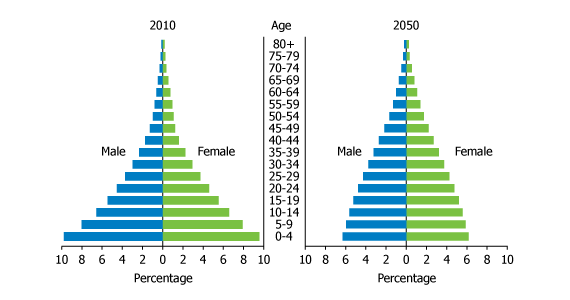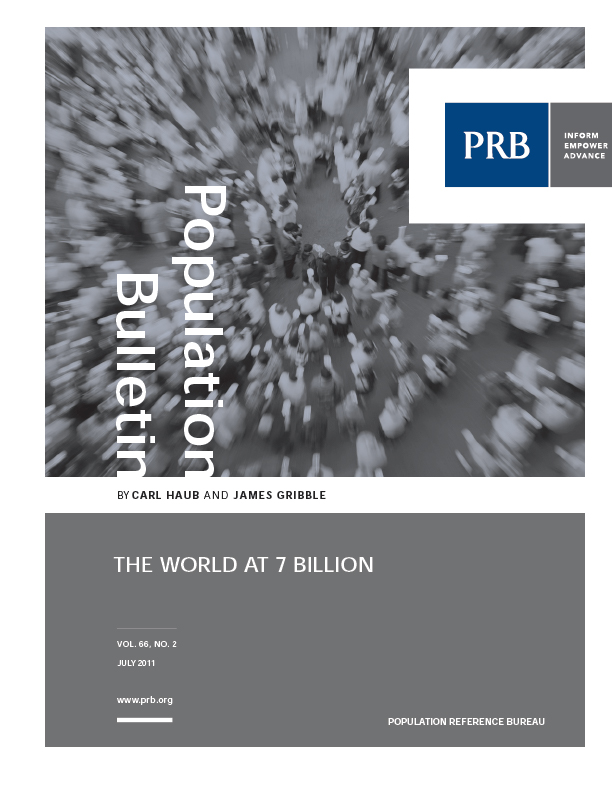
Uganda: At the Beginning of a Transition
Date
July 15, 2011
Author
This article is taken from the Population Bulletin:The World At 7 Billion, which looks at the four phases of the demographic transition as descriptive of past and future population growth. Four countries are highlighted to illustrate each phase and its implications for human well-being.
Uganda has entered into its demographic transition by reducing its once-high death rate. As a result of lower mortality but still high fertility, Uganda has developed a very youthful age structure.
Uganda’s population will continue to grow because of the large number of people who are either currently at an age when they are having children or who will soon enter that age group. With half of its population age 15 or younger, Uganda stands out as one of the world’s youngest age structures. As the world reaches 7 billion, countries at the beginning of their demographic transition represent a relatively small proportion—about 9 percent—of the world’s population. However, these countries face similar development challenges.
Overview
With a population of 35 million, Uganda is one of Africa’s largest and fastest-growing countries. Uganda has several policies and action plans that address its major population and development issues, yet none effectively address the country’s fertility, which is among the highest in the world. Despite economic growth in the past decade, many Ugandans live in poverty and confront social and economic inequities.
To understand Uganda’s population challenges, one must examine the roles and status of women. Ugandan women are greatly affected by HIV/AIDS, as is the case in many sub-Saharan African countries. In addition, maternal and child health indicators for Uganda show that women and children have very limited access to health services. Even though the country continues to improve the health of its people, Uganda will need to address its high fertility, increase the number of youth who attend secondary school and higher, and foster job creation so that its families, communities, and the nation as a whole grow economically.
Age and Sex Structure of Uganda, 2010 and 2050

Source: United Nations Population Division, World Population Prospects: The 2010 Revision (2011).
Population and Policies
The factor driving Uganda’s current population growth of 3.3 percent per year is a total fertility rate (TFR) averaging between six and seven lifetime births per woman. This level is only a slight reduction from the high level in the 1970s of 7.1 children per woman. If the current fertility level persists, Uganda’s population will double to 70 million by 2031, and could reach 100 million after 2040.
One reason for this high TFR is that only about 18 percent of Uganda’s married women between ages 15 and 49 use effective contraception, with injectable contraceptives, pills, and sterilization the most popular methods. An additional 41 percent of married women want to postpone or avoid pregnancy but are not using an effective family planning method.
Uganda’s 2008 population policy prioritizes birth spacing and youth-friendly sexual and reproductive health services, and allocates funding for these programs. Two focal areas of Uganda’s National Population Policy Action Plan 2011-2015 are sexual and reproductive health and rights, and gender and family welfare. In spite of these and other policies, Uganda’s government shows relatively little support for family planning. For example, government funding for contraceptives is not sufficient even to address the needs of women living in urban areas, who represent only 15 percent of the total population. The lack of public support for family planning by national leaders is visibly noticed by the global community.
Economic Inequalities
Uganda’s gross domestic product is growing annually at a rate of 5 percent to 10 percent. Historically an agriculturally based economy, the discovery of oil in 2006 offers Uganda an opportunity for economic growth and diversification. Yet Uganda is still a resource-poor country and 65 percent of its population lives on less than US$2 per day. This inequality is stark: The wealthiest 20 percent (quintile) of the population holds 49 percent of total income, while the poorest quintile holds only 6 percent.
According to the 2006 Uganda Demographic and Health Survey (DHS), wealth distribution is closely related to fertility. Women in the poorest quintile have eight children on average during their lives, while women in the wealthiest quintile have just over four children. Similarly, 41 percent of young women ages 15 to 19 in the poorest quintile have begun childbearing, while only 16 percent in the wealthiest quintile have. These differences are further reinforced by the practice of child marriage: More than half of women in all but the wealthiest quintile are married before age 18.
Gender Inequalities
Like many countries that face development challenges, one of the barriers impeding progress is gender inequality. Gender roles play out in virtually every aspect of life—from educational attainment among youth to decisions made within families. In households where the 2006 DHS was conducted, men age 20 or older always had higher levels of education than women of the same age. However, females under age 20 had roughly the same education as males, suggesting greater attention to educating girls. Women’s empowerment remains elusive—men indicate that family size is primarily their decision (47 percent), though many see it as a joint decision (45 percent); few (5 percent) see it as the woman’s decision. Women reinforce their own lack of power as well: More than 70 percent of women thought that a husband could be justified for hitting or beating his wife, suggesting a cultural acceptance of violence against women.
Gender inequalities also play out in the HIV/AIDS epidemic. According to the 2010 Uganda Report to the United Nations, 6.4 percent of Ugandans between ages 15 and 49 are infected with HIV. However, young women experience much higher rates of infection than young men. For example, among 20-to-24-year-olds, 2.4 percent of men are HIV positive, compared to 6.3 percent of women. Prevalence is highest among women ages 30 to 34, at 12.1 percent, compared to 8.1 percent among men in that age group. Although AIDS continues to contribute approximately 64,000 deaths per year in Uganda, these deaths do not offset the population growth resulting from the approximately 1 million births each year in Uganda.
Health of Women and Children
Like other countries in the early phase of the demographic transition, Uganda has one of the world’s highest maternal death ratios—approximately 430 deaths per 100,000 live births. Although most women receive some antenatal care, only about 47 percent receive four or more visits and only 42 percent have a skilled attendant at delivery. These statistics vary greatly across Uganda’s nine regions.
Deaths among children under age 5 continue to decrease in Uganda, and currently fewer than 13 percent of children die before reaching age 5, due mainly to neonatal causes, malaria, pneumonia, and diarrhea. This reduction in child deaths is partly a result of higher levels of full immunization and better care at delivery, as well as better use of health services when children are ill. However, poor nutrition undermines the health of most children: 73 percent have anemia and 38 percent are stunted (low height for age).
Challenges
Uganda’s continued rapid population growth, according to the United Nations high projection, will expand its population in 2050 to 105.6 million; half the population would be age 20 or younger—significantly older than the current median age of 15. However, if fertility remains at a level of 6.7 children per woman (from the 2006 DHS), Uganda’s population could be as high as 145 million by 2050 and have the same youthful structure as it currently has. To address this challenge, Uganda will need to focus not only on family planning to slow its population growth, but on wise investments that will help develop an educated labor force and create jobs to sustain and increase its recent economic growth.
Previous: World Population Growing at Record Speed
Next: Phase 2: Guatemala: Beyond the Early Phase of the Transition

 ">
">





